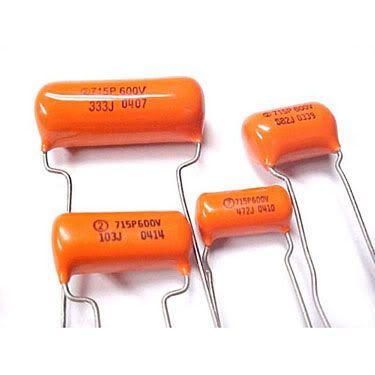Friday, Dec. 31, 2010, 1 a.m. — Finally started digging into my Detrola 571X receiver, removing caps and replacing them with “orange drop” capacitors that recently arrived.

This recapping is much different than the later model RCA I recently recapped: The Detrola actually has more components and more capacitors than the RCA, and the original caps were wired tightly around other components. In most cases, I’m replacing tubular wax-and-paper capacitors with these orange drop guys that are about 1/3 the size, and one of the hazards is making sure the leads don’t short.
I realized tonight that I missed a cap when I ordered replacements from Antique Electronic Supply. Not a big deal, but frankly, I didn’t want to replace all the caps but one, and then have to go back in to replace that one later.
I’m been a little bumfuzzled by how the filter caps are installed; or I should say filter cap — its a dual section electrolytic. It has two sections, I get that, but there’s a terminal on the bottom that appears to be used solely as a junction point for two components; I’m not sure if this ties them to chassis ground or not. I’m going to have to get out the VOM and take some measurements. I’m thinking of leaving the original chassis-mounted electrolytic in place; the new replacement is smaller, and there’s room under the chassis to mount it.
I ordered the missing cap earlier tonight — it’ll be here early next week. I can go on and replace other caps I guess. From now on, I’ll get the Rider manual or the service info on the radio before I order parts.
WHICH WAY DID THEY GO? Part of my initial delay in getting started was my having laid the parts aside and not being able to find them. Of course I did, but there were some anxious moments on my part. Something rather odd about these parts is the fact they values aren’t marked on them. They have a part number and voltage rating, but nowhere does it actually say the value of the capacitor. If I didn’t have the packing list from Antique Electronic Supply I would be in a world of hurt! Each part is packed in its own bag, and I took the liberty of marking each bag with the part value.
DETROLA NOTES. One of the interesting things about the Detrola 571X is the fact that it is changes inductance to tune rather than a big variable capacitor. A number of manufacturers used that method, though others did not; in the ham field, Drake used the variable inductance tuning on the R4x lineup.
 ADDENDUM: I went back to work on the Detrola and realized that I misread the part values on a couple of the caps. There are some very small value mica caps in the bowels of the receiver, and they are rated in micro-micro-farad — or in today’s terminology, picofarad. Unfortunately, I goofed when ordering these caps by not being careful to watch the number of decimal places. So now I have placed an order for the correct value caps to replace these. If the difference in value wasn’t so large, I wouldn’t mind, but these are coupling caps, and the difference in value is significant when you go from hundreds of picofarads to thousands.
ADDENDUM: I went back to work on the Detrola and realized that I misread the part values on a couple of the caps. There are some very small value mica caps in the bowels of the receiver, and they are rated in micro-micro-farad — or in today’s terminology, picofarad. Unfortunately, I goofed when ordering these caps by not being careful to watch the number of decimal places. So now I have placed an order for the correct value caps to replace these. If the difference in value wasn’t so large, I wouldn’t mind, but these are coupling caps, and the difference in value is significant when you go from hundreds of picofarads to thousands.
That’s all this entry … stay tuned!
-30-
